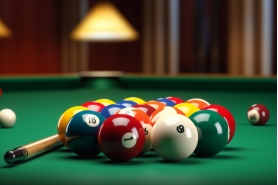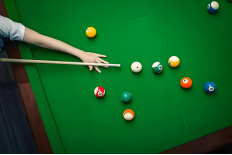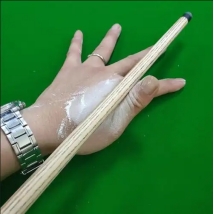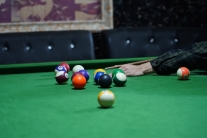Thought process:
People who play billiards start from their initial understanding of billiards. As their interest grows and their billiards skills improve, they gradually deepen their knowledge. From not knowing where to start at the beginning to being able to see the whole situation just by hitting one ball, and then controlling the whole game until achieving victory.
This change occurs in the depth of understanding of the ball. In a nutshell, the way of thinking is different. When the skill level improves to a certain extent, the thinking will become very clear. Whether it is an offensive or defensive strategy, it can be applied appropriately and reasonably.
Now it seems that improving one’s skills is of utmost urgency. Some people say that so-and-so plays well, which is nothing more than that he is accurate in hitting, has good cue techniques, exerts the right amount of force, and has an excellent psychological quality. It doesn’t mean that he can clear the table with every shot.

Aiming:
During the process of playing billiards, some people are accurate while others are not. Or there are certain types of shots that I am good at and can handle with ease, while for other types of shots, I don’t perform well and make more mistakes. I believe everyone has had such experiences. In fact, if we look at this issue from a physical perspective, we may gain some insights. As we all know, the diameter of a billiard ball is smaller than the diameter of the pocket. As long as the ball is within the allowable range of the pocket, it can generally go into the pocket. By using the method of backward reasoning, we just need to ensure that the ball is within such an error range.
How can we ensure that the error of the ball is as small as possible? I have looked up a lot of information and found that when playing, instead of looking at the cue ball, we should look at the target ball. From the standard playing posture, the cue is usually directly below the chin and between the two eyes. In this way, as long as we can see the middle point of the pocket and the point at the other end of the diameter of the line connecting the center of the target ball, and make a calm and decisive shot, the target ball can go into the pocket.
Some people say that this method works for straight shots or shots with a very small angle, but it doesn’t work when the angle is large. In fact, this problem is easy to solve. Just take into account the radius of the cue ball. After the cue hits the cue ball, the cue ball moves in a straight line, which is equivalent to the extension of the cue. At this time, although you are aiming at the correct point, if you observe carefully, you will find that the cue ball cannot hit the point you are aiming at. That is to say, the first point that contacts the target ball is not the front point of the cue ball that passes through the center of the ball at the contact point between the cue and the cue ball. Therefore, during the process of hitting the ball, appropriately offset a little bit. After a period of training, you can also hit the ball with great accuracy.

Cue Techniques:
Generally speaking, the cue ball is divided into nine areas, and hitting the ball in each area is named respectively: The center shot, hitting the middle part of the ball, can transfer all the energy to the target ball, and the cue ball stops, commonly known as the stop shot. The follow shot, hitting the upper part of the ball, can transfer all the energy to the target ball. The cue ball stops first and then rotates and moves forward, commonly known as the follow shot.
The draw shot, hitting the lower part of the ball, can transfer all the energy to the target ball. The cue ball stops first and then rotates and moves backward, commonly known as the draw shot.
The left english shot, hitting the left side of the cue ball, creates an arc like this ).
The right english shot, hitting the right side of the cue ball, creates an arc like this (.
The right draw shot, hitting the lower right side of the cue ball, the running track first appears as ( and then the draw shot is executed after hitting the ball.
The left draw shot, hitting the lower left side of the cue ball, is similar to the above situation.
The right follow shot, hitting the upper right side of the cue ball, is similar to the above situation.
The left follow shot, hitting the upper left side of the cue ball, is similar to the above situation.
These are the basic ones. Of course, there are also advanced cue techniques, such as the jump shot and the masse shot.

The key to the jump shot is to aim at the center of the ball, generally hitting the upper middle part of the ball (it can also be the lower middle part) and exerting force, and quickly pulling the cue.
The key to the masse shot is to master the principle of parallel lines. Reasonable use of cue techniques can achieve surprising and winning effects.

Accessories:
To make every shot go into the pocket, in addition to having good skills, a good cue and a good billiard table are essential. We are the source manufacturer of Spike billiard tables. Our products meet international standards and create an exclusive high-quality life for you. We can customize personalized billiard tables according to your needs. https://www.tiktok.com/@spk.billiard?_t=8qRRRnXP4N8&_r=1
